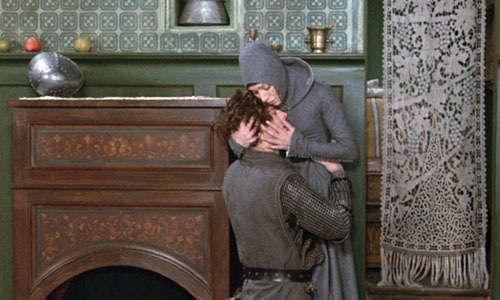
Walerian Borowczyk’s Blanche (1971) might be the most authentically medieval film that I have ever seen. Borowczyk’s production design is authentic and detailed, his framing intentionally recalls the illuminated manuscripts of the period, and the music is historically accurate to the period, but beyond that there is the narrative itself which is structured like a medieval narrative poem. Blanche was the last feature film that Borowczyk had total control over which is why his interests are so prominently displayed without being curbed by the inclusion of gratuitous scenes of sex at the behest of producers.
Borowczyk’s visual dialect in Blanche consists of two kinds of images. First there are the static frames designed to mimic the illustrations in illuminated manuscripts and icon painting which lends the film a Brechtian kind of theatricality. Then there are the short insert shots that interrupt these longer static takes. The insert shots themselves are far more kinetic, often shot hand-held, and work either towards narrative continuity or as a form of detail. Cutting from one to the other Borowczyk’s editing imbues Blanche with a dreamy, almost fairytale quality. These visual strategies therefore reenforce the moral tale that is the narrative.
The story is typical of medieval poetry and ballads focusing on a virtuous and pious young lady navigating a man’s world where chivalry and honor clash with the forces of corrupt power. Blanche (Ligia Branice) herself appears childlike, particularly in contrast with her husband played by Michel Simon. Issues of adultery and faith form the core of Blanche’s journey and Borowczyk treats this material far more delicately than in his Contes immoraux (1973) where Freudian notions of sexuality seem to prevail. The comparative simplicity of medieval morality tales plays to Borowczyk’s strengths as an author of beautiful images rather than his weaknesses in terms of constructing complex characters.
Blanche suggests many of the ideas and fetishes that dominate Borowczyk’s subsequent features, bridging the gap between his career as an animator and his career as a pornographer. He had already made a live action feature before Blanche, Goto, l’île d’amour (1968), that lacked the stylistic cohesion of Blanche and favored the narrative expediency of his animated shorts. Goto, l’île d’amour is Borowczyk’s most influential feature but his masterpiece is clearly Blanche.
